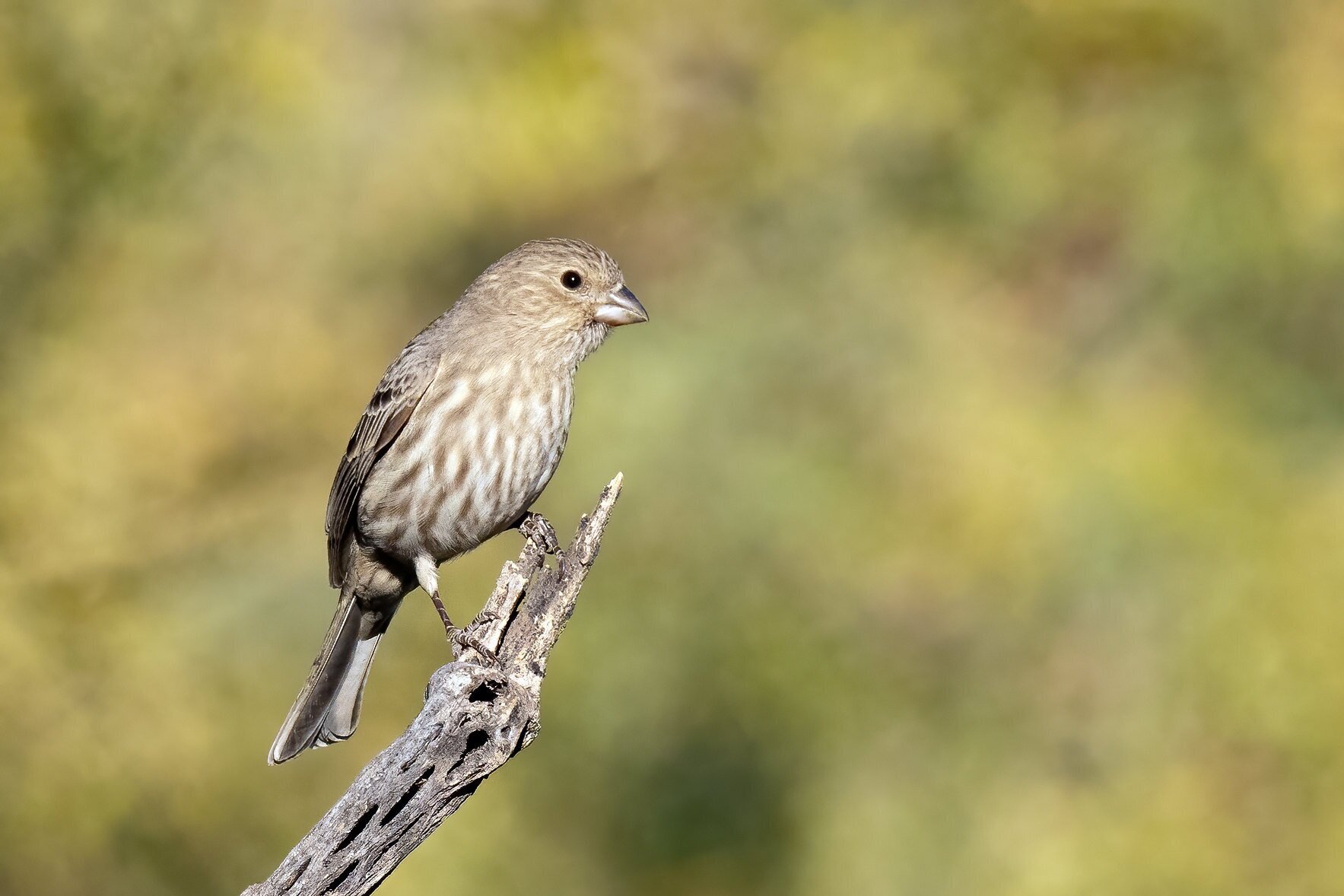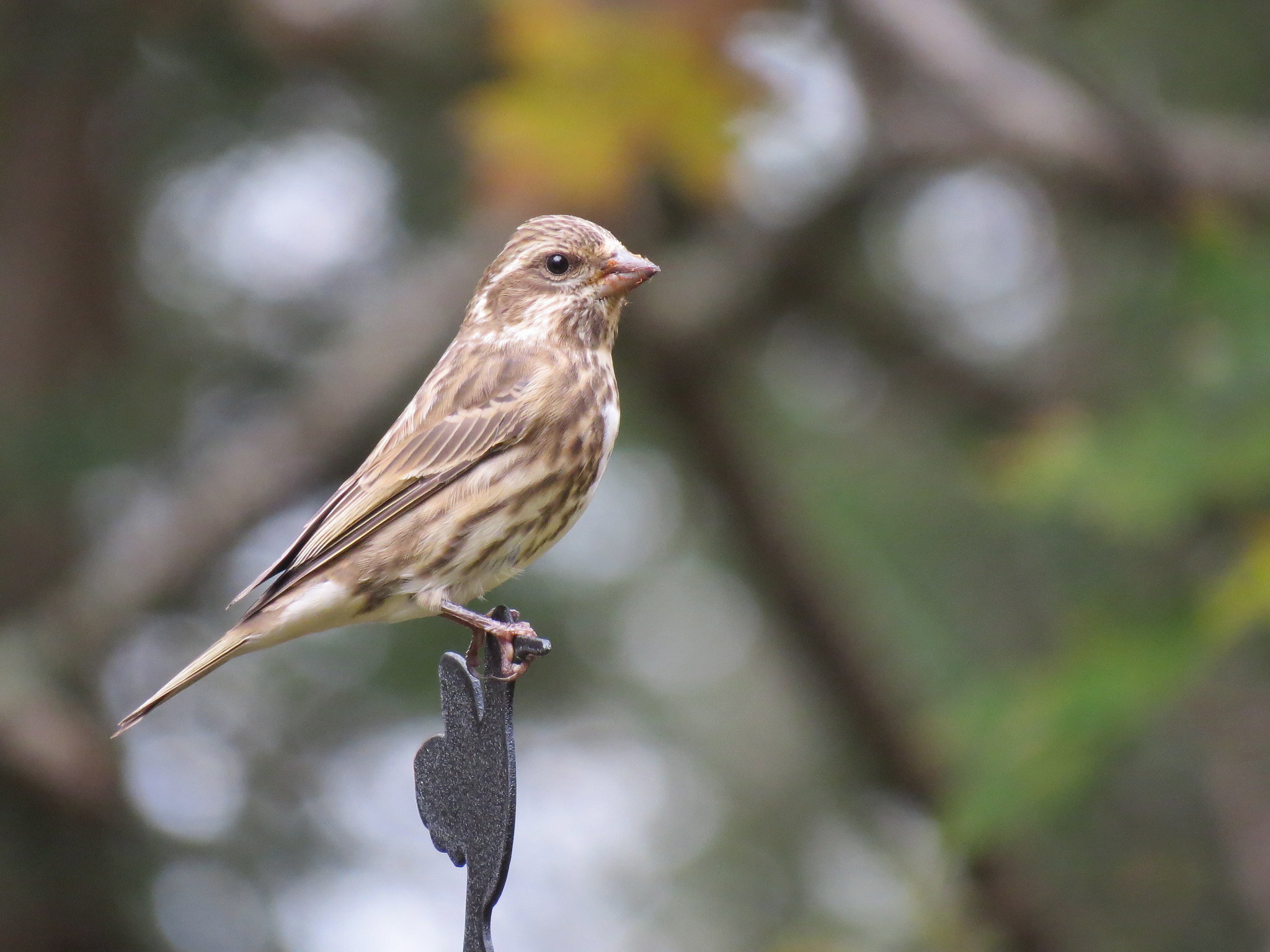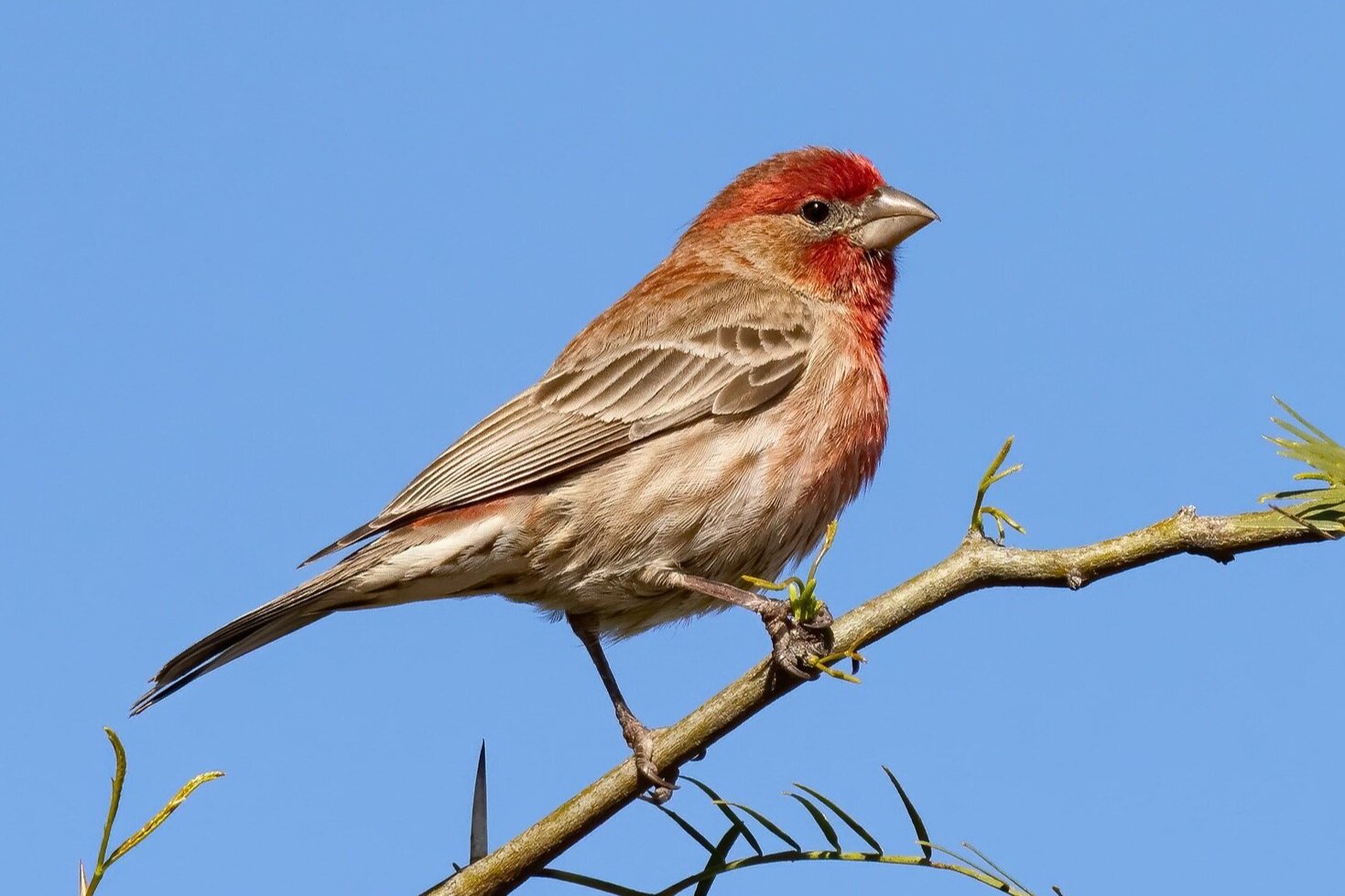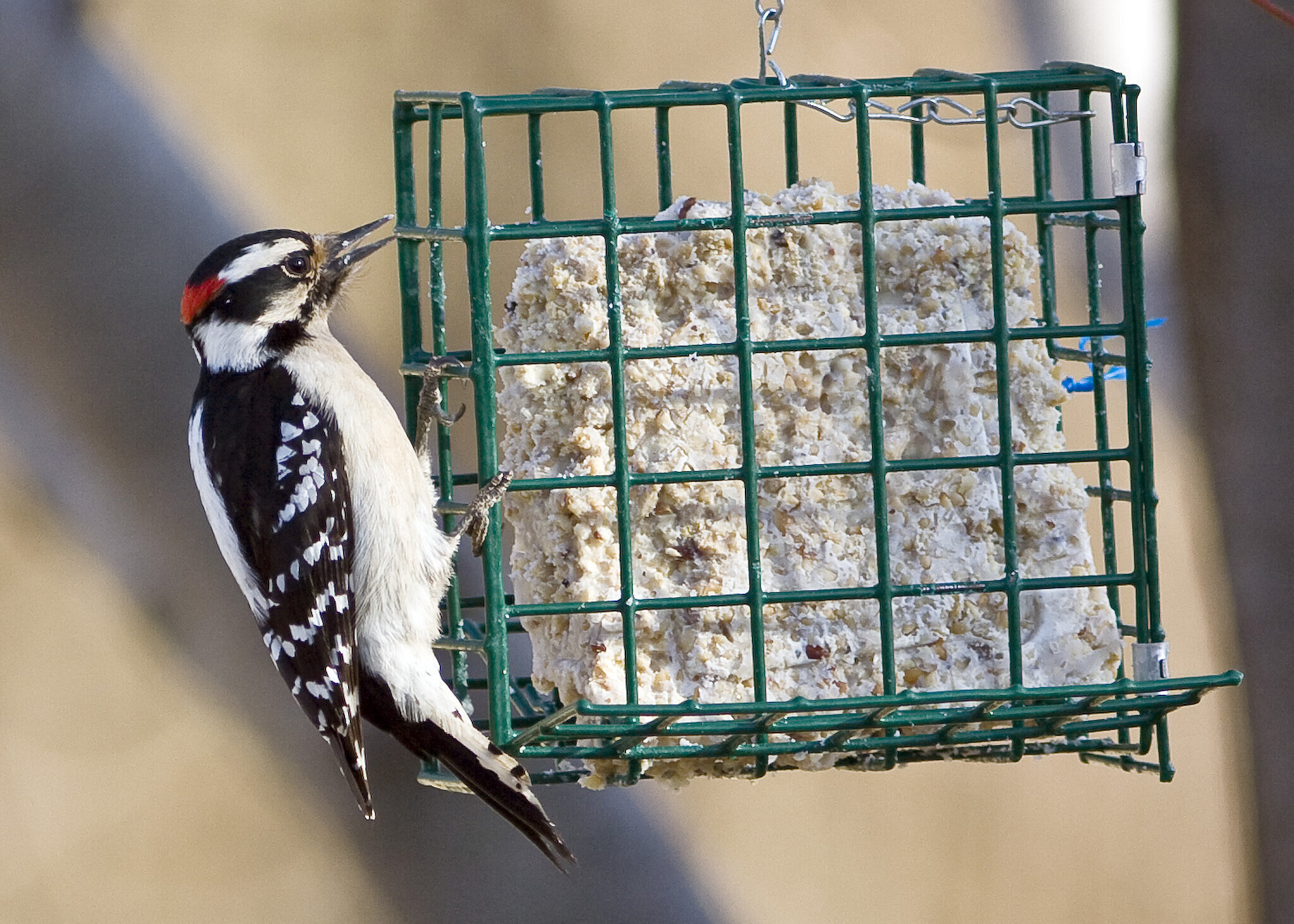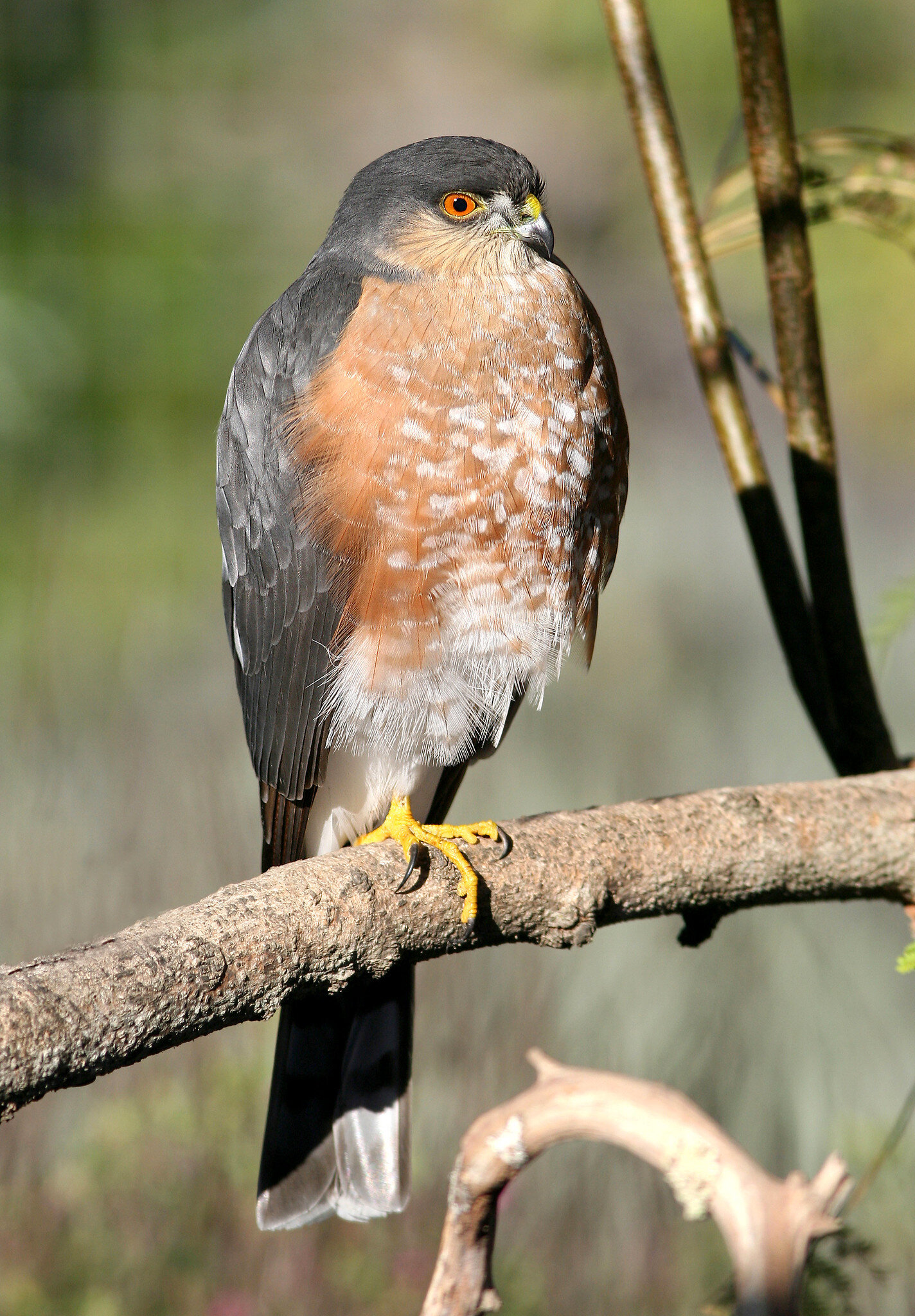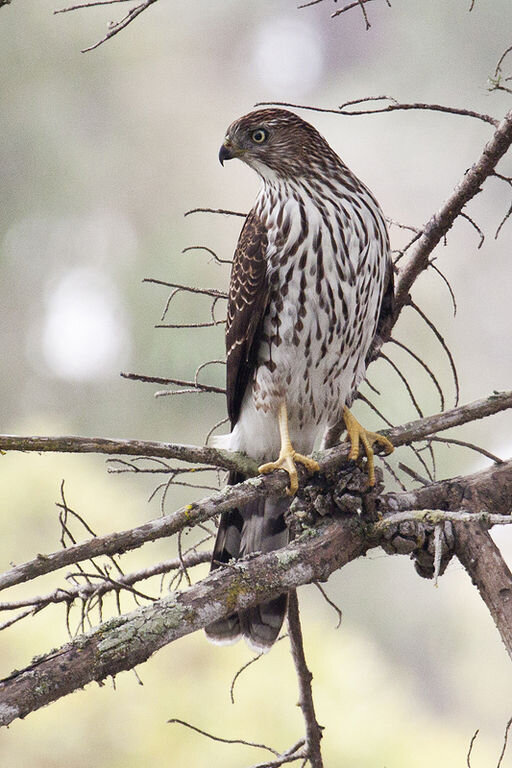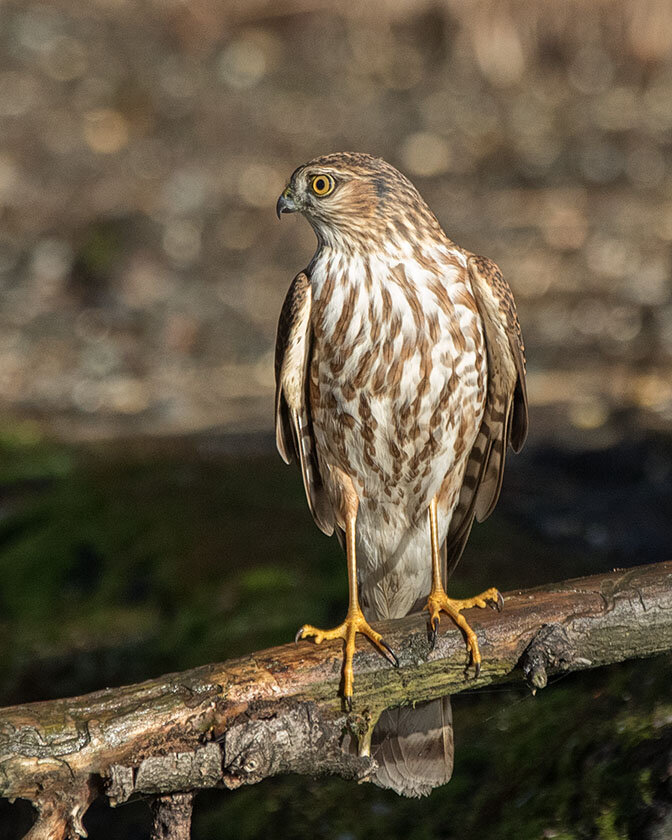Guess what’s coming up this Friday, February 12th? It’s the return of the Great Backyard Bird Count, a community science project designed to collect data about the presence of birds in winter. And oh boy, the count is right on time—we are entering into a very cold, very frigid week that will make getting outside a challenge. What better way to hunker down at home than with a blanket, a warm beverage, and your trusty binoculars?
This week’s Entryway to Birding blog pulls up a chair to the window and takes a look at what birds you might find near your home—whether you’re looking into a backyard or an apartment complex parking lot. Learn about the most common visitors you might see in south-central Wisconsin this winter and get some identification tips for some especially tricky backyard birds!
Don’t be surprised if you see an American robin! I saw the bird pictured here enjoying the snow-covered fruit trees at the UW-Arboretum. Many people associate robins with migration. It’s in their Latin name, after all—turdus migratorius! But while a good portion of American robins will migrate south, many choose to overwinter, especially if they have access to food and water. They are incredibly cold-hardy and will switch up their food sources to match the colder season, swapping worms for berries. Photo by Caitlyn Schuchhardt
What is the Great Backyard Bird Count?
There’s two steps to the Great Backyard Bird Count. Step 1: Observe your surroundings for at least 15 minutes. Step 2: Submit what birds you saw! That’s it! Photo courtesy of The Great Backyard Bird Count
The Great Backyard Bird Count is a yearly event, usually on the second weekend in February. This year, it runs from Friday, February 12th through Monday, February 15th. Participants from all over the world spend at least 15 minutes observing their surroundings on one or more days of the count, then report what birds they see by entering their checklist online.
You can participate from anywhere—even beyond the confines of your backyard, if you’re up for braving the cold weather! Once you go birding for 15 minutes (or longer, if you’d like!), you can submit your sightings. Submitting what you’ve seen is easy. You can use Merlin Bird ID app to identify birds you see and submit your sightings directly from Merlin, or you can submit directly through eBird, on your phone or on your desktop. Read more detailed instructions on submitting your observations here.
Last October, we learned about how eBird data can help us understand how birds respond to extreme weather. Did you miss Jeremy’s presentation? Don’t worry, it was virtual! Watch the recording of his live presentation here.
The data you help collect during community science events like this is really helpful for scientists who are studying bird populations and the distribution of birds. And, with this recent cold snap, recording bird activity can be especially important. Do you remember our Evenings with Audubon event from last October? We heard from post-doctoral candidate Jeremy Cohen about how his research uses eBird data to study how birds respond to extreme weather events, like periods of high heat or cold, high rainfall or drought, and more.
While no one exactly looks forward to a polar vortex like this, we can look on the bright side and think about how reporting bird activity in these very cold periods is good for birds and bird science!
The Who is Who of Backyard Winter Birds
There’s a surprising amount of bird species that you might see in your neighborhood throughout the winter. It can be difficult to keep track of them all—especially if they don’t sit still for long! To help you get accustomed to some of the most common birds you might see, Madison Audubon put together a handy two-page guide you can print and use for reference.
Our “Winter’s Wonderful Backyard Birds” guide shares pictures of our most common backyard bird species, plus a fun fact to help you remember each bird. Do you recognize any of these visitors in your neighborhood?
This isn’t an exhaustive list of your potential yard visitors, though, just some of the most common. The more time you spend observing birds in your area, the more familiar you’ll become with these birds … and the more you’ll start to recognize when you see something less common!
Up next, we’ll look at how to ID a few of the more “tricky” backyard birds, especially those who have some close look-alikes that may leave you feeling confused.
Tricky Backyard Bird IDs
There are a few species you can find in your backyard that can look surprisingly similar, especially if you only get a quick glance. We’re going to take an in-depth look at how to distinguish a house finch from a purple finch, a downy woodpecker from a hairy woodpecker, and a Cooper’s hawk from a sharp-shinned hawk. These last two raptors aren’t featured on our winter bird handout, but I’m willing to bet that you may have one frequenting your neighborhood. If you notice your active yard suddenly gets eerily quiet, it may be worth a scan to see if a new arrival has entered the scene …
Let’s get started!
House Finch vs Purple Finch
House finches are year-round residents in south-central Wisconsin, but purple finches are only fall and winter visitors. Some years purple finches come in good numbers, and some years they don’t—they are one of those “irruptive” winter finch species that we talked about in our winter finch irruption blog from earlier this year.
The challenge is that house finches and purple finches can look very much alike—and depending on the lighting you’re dealing with, their colors can seem subdued or saturated, adding some mystery to the mix. There is a definite possibility that you may see a purple finch this winter—they are being reported in our region this year—but they are not nearly as frequently seen as house finches. But if your yard or neighborhood attracts a lot of house finches, you should look at them carefully to see if you can spot a purple finch among them.
Let’s take a look at a female house finch and a female purple finch to get started.
Female house finch by Mick Thompson / Female purple finch by Colleen Prieto
Notice in the pictures above, the female house finch’s head is a very uniform, solid brown. Her body’s plumage is rather nondescript, also brown but with soft, blurry streaks. But the female purple finch, on the other hand, has a more sharply patterned face. She has a white eyebrow that runs behind her eye instead of a fully brown head. Her body’s plumage is also brown and streaky, but her streaks appear a bit more stark and contrasted, rather than the overall buffed out streaks of the house finch.
Like the male house finches we’ll look at next, the body of the female house finch also tends to appear more slender, while the body of the purple house finch is a little more robust with a larger-looking head.
The male finches will be where color comes into the equation. I honestly think they can be a bit trickier to ID than the females—that white eyeline is a good giveaway for female purple finch, but the red coloring on a male can seem very variable depending on the bird and your viewing conditions. Here are two photos we’ll use for comparison: first a male house finch, then a male purple finch.
Male house finch by Mick Thompson / Male purple finch by Alan Schmierer
Male house finches will sport more of a “brick red” coloring, primarily on their head, upper chest, and rump. Male purple finches will have more of a “raspberry red” or “wine-colored” coloring, with more of a reddish-purple hue. Their coloring extends from their head down their chest and back, and you can see hints of it on their wings and flanks. A good trick is to look not at the head of the bird, but at their lower half—a male house finch will have brown flanks and brown on its wings, while a purple finch is going to show hints of that deep, red-wine coloring all the way down.
Male house finches will often have a brown cheek patch on the side of their face, even though the rest of their head is red. Can you see that brown patch on the house finch pictured above, just below and behind the eye? That same area on a purple finch, though, will sport that deep purple-red.
Have you seen a purple finch in your hard? Tracking the presence of irruptive species like these winter finches is really useful—that’s why participating in the Great Backyard Bird Count is such a great idea!
Downy woodpecker vs hairy woodpecker
These two woodpeckers are both fairly common backyard visitors that will come to feeders that provide suet. If you live in an area with lots of deciduous trees nearby, you might find them drumming away there too!
Downy woodpecker by George Thomas / Hairy woodpecker by David Mitchell
Downy woodpeckers look like a smaller or “downsized” version of a hairy woodpecker. They are smaller in size with a shorter, stubbier bill, but their overall black and white coloring is mostly the same as a hairy. Their bill is usually the best way to differentiate them from a hairy woodpecker, unless you have both birds in your yard at the same time to do a size comparison. Look for a short bill that is only about half the length (or less) of the downy’s head.
Hairy woodpeckers, on the other hand, are “huge” in comparison (that alliteration can help you remember their differences!). Their bill is longer—about the same length as their head—and their bodies are larger too.
If you aren’t able to get a good look at the bill due to the angle the bird is showing you, you might also try looking at their tail feathers. A downy woodpecker will show some black spots or stripes on the edges of their white outer tail feathers, while a hairy’s white outer tail feathers will usually be unmarked. I remember this unique tip with the phrase “Downies have dots!” (More alliteration for you!) However, this can be a challenge to spot depending on your angle, so it’s only useful sometimes. Can you spot the downy’s dots on its white tail feathers in the image above?
Cooper’s Hawk vs Sharp-Shinned Hawk
Your neighborhood might have a resident hawk that’s also scoping out your yard. Have you spotted one yet? The most common backyard raptor is going to be a Cooper’s hawk, but it has a close look-alike in the sharp-shinned hawk, another potential backyard find (though a bit less common in urban areas than the Cooper’s hawk).
These two birds can provide new birders and experienced birders alike a bit of a headache, because they can look similar in both their juvenile and adult plumages, and depending on how you see them, you might not always get your eyes on the field marks you need.
Let’s look at the adult birds first. Below is an adult Cooper’s hawk on the left, and then an adult sharp-shinned hawk on the right. Both of these birds are accipiters that will show long, thin tails while perched. A Cooper’s hawk is larger than a sharp-shinned hawk—sharpies are quite small raptors, about the size of a blue jay!
Adult Cooper’s hawk by Andy Reago and Chrissy McClarren / Adult sharp-shinned hawk by Alan Schmierer
Notice how both birds have the same dark blue/gray coloring on their head, back, and wings, and the same red barring on their front. If you look carefully, though, you’ll see that the Cooper’s hawk’s nape (or the back of its neck, which you can only see from the side here) is paler in comparison to its head and sides. This makes it look like the Cooper’s hawk is wearing a dark cap. The sharp-shinned hawk, on the other hand, has a dark nape that matches the color of its head and back, making it look like it’s wearing a fully dark hood.
Sometimes that nice clear “cap” on a Cooper’s is really visible, but sometimes shadows and lighting can fool you. You should also look at the shape of their heads—a Cooper’s hawk will have a strong, square head. A sharpie, though, will have a rounder head with less of a neck, making their head look like a scoop of ice cream on top of a cone. Another silhouette tip that may help is their overall body shape—see how slim and tubular the Coop is in comparison to the broad-shouldered, barrel-chested sharpie?
Juvenile Cooper’s hawks and sharp-shinned hawks will share those same profile and shape features, but their plumage will differ slightly. Look at the two birds below, the Cooper’s on the left and the sharpie on the right.
Juvenile Cooper’s hawk by Bill Bolton / Juvenile sharp-shinned hawk by Joseph Higbee
Notice the neat, fine teardrop shaped streaks on the chest of the Cooper’s hawk. Compare them to the thick, blurry, messy streaks on the chest of the sharp-shinned hawk. The style of the breast streaking is often the next best way to distinguish between the juvenile species.
In the photos above, the head shape isn’t proving as useful as it was in earlier pictures due to the bird’s pose—that happens a lot! Another field mark we could use in this instance is, surprisingly, the feet! Look at the sturdy, thicker legs on the Coop compared to the thin, skinny legs on the sharp-shinned hawk.
If you’re not lucking out with your angles or view of the field marks mentioned above, it’s also worth noting that Cooper’s hawks will usually have graduated tail feathers (meaning not all their tail feathers are the same length). A sharp-shinned hawk usually will have tail feathers that all appear the same length. This field mark, though, is best used in conjunction with other marks, since it is one that can be highly variable from bird to bird. Take a look at the cropped photos of the tails from the above juvenile pictures, below:
Bonus Backyard Bird: Carolina Wren
House wrens have migrated south for the winter, but if you thought you spotted something that looked characteristically “wren-like,” you might have a special guest. You should keep a close eye out for Carolina wrens, a wren species that is more frequently overwintering in our region. This wasn’t always the case, though! The range of the Carolina wren is expanding due to climate change.
I had been trying for so long to get a picture of a Carolina wren. I was so excited to see this bird in late December as part of the Christmas Bird Count. Photo by Caitlyn Schuchhardt
Carolina wrens will be a buffy tan on their front, with a brown back and a finely barred tail that they will often carry cocked upright. Larger in body than a house wren, they’ll have a long, slightly decurved bill like their house wren relatives, but will sport a distinct white eyebrow—their signature field mark.
Birds can be surprising. You never know what you might find, even right in your backyard—or, in my case, my apartment complex parking lot. Even if you think you don’t live in a particularly “birdy” area, there may be signs of winter life hiding under your nose. This cold snap gives us a good excuse to spend some time at the window with some patient, careful observation and see what other life shares our urban space.
The Great Backyard Bird Count starts this Friday, February 12th and runs through Monday, February 15th. I encourage you to challenge yourself to some local birding—at your window, at a local park, at any spot you feel so inclined. 15 minutes of observation is all it takes!
Want to brush up on more ID skills? Project FeederWatch has some more tricky bird ID tips for you!
If you’d like to see what other participants from around the world are reporting, you can watch a live map of real-time checklist submissions here. If you’d like to learn more about participation in the Great Backyard Bird Count and how this data helps support bird conservation efforts, you can register to attend a free Facebook livestream offered by The Cornell Lab of Ornithology tomorrow, Tuesday, February 9th at 11am CT , or visit the Great Backyard Bird Count website at birdcount.org.
That’s all for this week! Happy backyard birdwatching!
_____
Caitlyn is the Communications and Outreach Assistant at Madison Audubon. She’s crazy for birds because they changed her life. She’ll be back next Monday with some tips and tools for birders, new and experienced! Between now and then, she’d love to hear about the birds you’re seeing and hearing. Leave a comment below or email to drop her a line!






